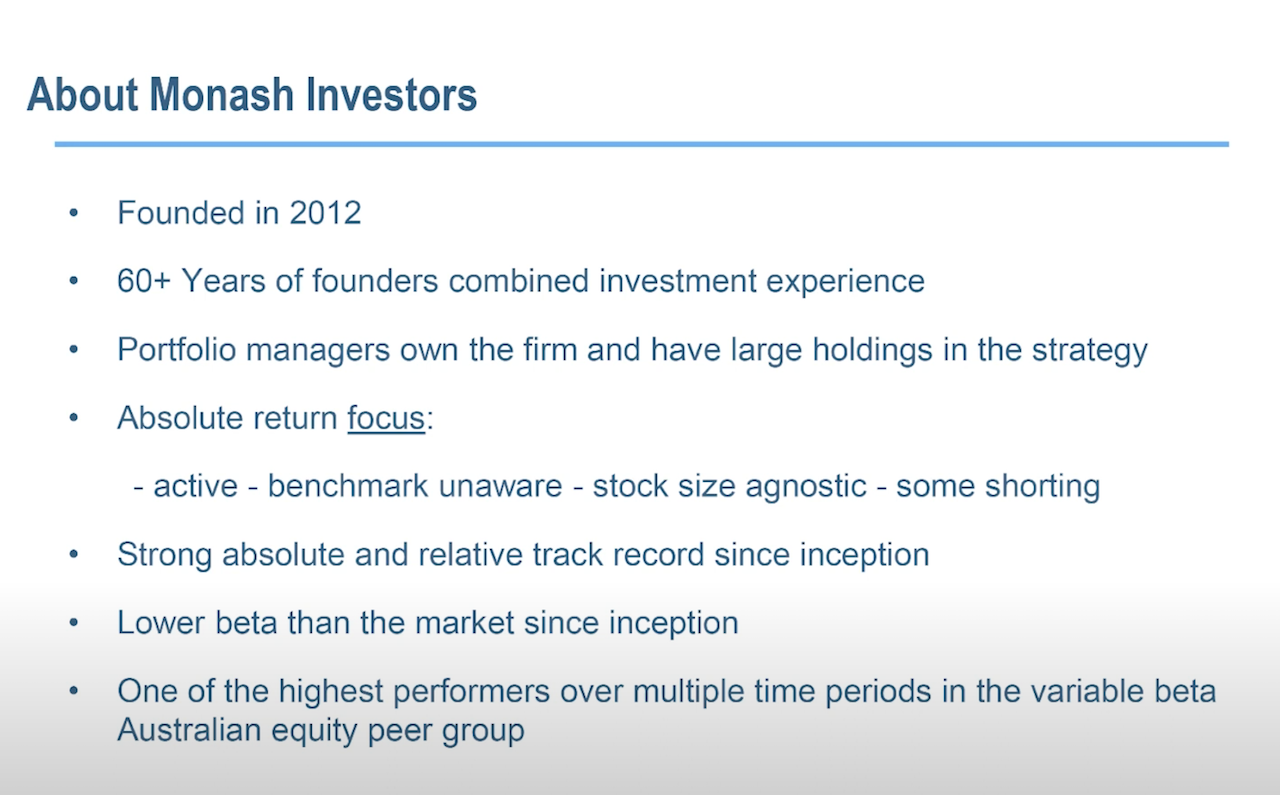3 objectives to create double-digit long term returns
Long-term investing success depends on how you go at it, and how you stay at it. It involves a strategic framework and a philosophy, the setting of limits, and discipline in execution - and much else besides. In this wire, and in the video below, I'm going to introduce you to Monash Investors' approach to investing in the share market, and explain how and why it works so well.
Monash Investors was established by Shane Fitzgerald and me in 2012. And we had a long history of working in the Australian share market. I was on the buy-side. I worked for value managers like UBS and growth managers like Colonial First State. Shane had been on the sell-side. He'd been an analyst for financial stocks for well over 20 years.
When we started the firm, we determined that we would do things differently from the vast bulk of other fund managers, which essentially were running portfolios just to beat an index and with an eye on those indices.
We took an absolute return approach. So every time we invested, it was on an absolute basis, quite benchmark-unaware, stock-size agnostic, including some shorting and of course, quite active.
The resulting portfolio has a much lower beta than the market. And it's been one of the highest performers in the peer group over quite long time periods. That's because of our flexible mandate. We can do things that if we had an eye on the index all the time, we just couldn't do.
We start with our objectives. The three objectives are to deliver a double-digit return after fees over the long-term, while seeking to preserve capital over the medium-term and paying out a 6% per annum distribution each year and we do that quarterly.
To find out more about the objectives and why they work please watch the video below.
This transcript has been edited for length and clarity

Ours is quite a concentrated portfolio, but the hurdles are very high. We're looking for at least 60% upside for our long positions and at least a 30% downside payoff for our short positions. And of course, we can invest in any short, of course, a long stock on the Australian share market. We're not tied to a particular growth or value style, but you'll see our portfolio tends to particular characteristics for the stocks that we're looking at that are both value and growth.
And, of course, we see ourselves as a satellite rather than the bulk of someone's portfolio. You get a measure of how active our funds management business is by looking at this chart, where you can see the light blue line is our net exposure to the market. It averages about 80% over time. So that means we've got cash levels of about 20% on average in the portfolio. That darker blue shows you the shorting. You can see it's only a smaller proportion of the fund. Overall, we have a long-biased fund.
Certainly stocks do go up over time, so there's not a lot of point in being short the whole market all the time.
It's very hard to find shorts, quite frankly, when you're really looking for absolute payoffs. We only invest in companies that are going to make us money. That is the longs or the shorts. That's an absolute downside payoff we're looking at for the shorts.
So what is our approach to investing?
Because it is a bit different from the average fund manager, we start with our philosophy that we think that most of the time, most stocks are fairly priced.
And by that, we mean within 10 or 15% of what they're worth. However, every year we can look back on the stock market and we can see that some stocks have done a lot better than that and some are a lot worse, but they're not the bulk of the stocks. The question is can we identify in advance some of those stocks that are going to do particularly well or particularly poorly each year?
Our key to doing that is to focus on recurring business situations or recurring patterns of behaviour. And by doing so, it helps us identify stocks that are going to be those performers up or down that are a lot different to the pack.
So a quick introduction to some of the things that we look for in terms of recurring situations, and the big one, of course, is an underestimation of significant change. This can happen in lots of ways. More typically it could be a company that's on a massive store rollout programme.
Think about McDonald's in its heyday or in Australia, Harvey Norman or JB Hi-Fi or more recently a stock like Lovisa.
There are lots of other sorts of significant changes that occur to businesses as well. It could be a product rollout. It could be that there's been a new technological development, that means it's a much more cost-effective choice for customers. And so it's grabbing a huge amount of market share and penetrating a market.
On the negative side, it could be that a new competitor has come in or it could be a changing government regulation.
So the market tends to underestimate these large step changes when significant changes occur for businesses. And that's a pretty regular situation that we see in the Australian share market, but there are other behavioural things.
It could be reputation management by board members, by management, or by analysts. It could be limitations in what they're able to tell you. Our ability to look at signals that would otherwise be overlooked by others with less experience in the market.
And we actually incorporate these things into our investment process as recurring business situations that we can draw upon to help us work out what is going to happen in the future to a business.
We forecast the revenues and the margins, and the balance sheet. And then we compare our view to that of the market and see what price we think the stock should be trading at today if the market agreed with us about our forecast for the future.
If we can get that 60% upside from the current price to the price we think it should be trading at today when the market agrees with us, then that's a long stock that we want to own. Likewise, if we can get a 30% downside, that's a short that we want to put into the portfolio.
When it comes to the stocks in particular we are looking for four things.
So the first thing, though, is that value, that payoff. How much upside is there to the price that we think the stock should be trading at today? How much downside? And of course, to get a value payoff like that, typically you do need step changes, so that's where the growth comes in.
It could be a step change up, or a step change down. Linking the two is that insight, that recurring business situation. Why is this stock misunderstood, and how is that misunderstanding going to be resolved by the market? And then if there's an event in there, all the better.
Of course, it's one thing to go out and find a portfolio of stocks that you think are absolutely fantastic value and are going to deliver terrific returns over the medium term.
On the other hand, things change and you have to know when to sell. It's that selling discipline that helps keep us out of trouble. To start with, we have a price target on every stock. As the stock approaches the price target, we trim our holdings. When there's less than a 60% upside left on our price target, we actually drop the absolute weight of the stock as well in the portfolio rather than just trim to maintain the weight.
The other reason why we might be selling a stock is that we've got something wrong.
And when we completely have misunderstood a stock and the rationale for our forecast are wrong, we call that an investment thesis violation.
Unfortunately, sometimes it's not so obvious that the investment thesis has been violated. So it's quite a late signal. Therefore, we have some early warning triggers in the portfolio so that we don't get caught holding onto a stock or falling in love with the stock that starts to disappoint us.
Three early warning triggers.
#1 The first one is if there's a spike in short interest, we'll cut the weight of the stock by a third. Well, of course, we might love the stock, but if there are enough people out there that don't, you'll see that short interest rise. And that is a warning signal to us and that triggers a cut in our holding of the stock.
#2 Another reason why we would cut by a third would be an unexpected downward earnings revision. So again, if it's unexpected and it's negative, we'll just cut it by a third.
#3 And then finally, likewise, we have these near-term sign-posts for stocks when we do our forecasts. It might be something like how many stores do you expect to roll-out to this year? What sort of return should you get on your marketing spend, for example?
If it misses a short-term signpost, we will also cut it by a third. If we have two of these early warning triggers close together, we have a two-strike rule, two strikes and the stock is out. And that certainly does happen from time to time. Using this disciplined investment approach of focusing on stocks where we think we have an edge because we can rely on recurring business situations that the market doesn't price.
And through having an absolute approach to the weights of the stocks in our portfolio and a good selling discipline when things are working or not working for us, we've been able to create a portfolio that's returned over 11% per annum since inception after all fees.
So meeting our criteria of double-digit returns per annum over time. It's a portfolio that is also preserved capital on a rolling three-year period and it's a portfolio that at the end of each quarter delivers at least a one and a half per cent distribution.
Now, these are only targets. Of course, there are no guarantees in the world of investment, but that's what we've been able to do since we started.
Benefit at every stage of a cycle
Monash Investors Limited invest in a small number of compelling stocks that offer considerable upside and short expensive stocks that are at risk of falling. Want to learn more? Hit the 'contact' button to get in touch or visit our fund profile below for further information.

3 topics
1 stock mentioned
1 fund mentioned
2 contributors mentioned


